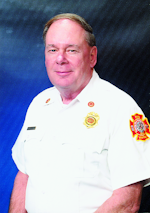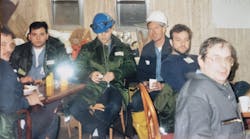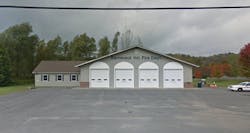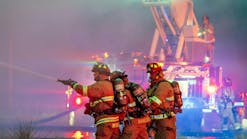This is the final installment of a three-part series about ethanol and reviews hazards and firefighter response procedures for ethanol emergencies in transportation and at fixed facilities. Emergency responders have been dealing with spills and fires involving gasoline and diesel fuel for over 100 years, but ethanol and its blends are fairly new in terms of use as a motor fuel and likely to present a challenge to emergency responders.
Since 2000, there have been reports of at least 25 incidents involving ethanol and its blends at fixed facilities and in transportation. As with any hazardous material, response personnel must be able to recognize when they are potentially dealing with an incident involving ethanol and its blends or just plain gasoline. Containers that are used to transport ethanol and its blends are called bulk containers and are required to carry placards with the United Nations (UN) four-digit identification number in the center that identifies the product. This number can be looked up in the U.S. Department of Transportation (DOT) Emergency Response Guidebook (ERG) to obtain emergency information. Following placards, one of the best sources of information is the shipping paper. Material safety data sheet (MSDS) can also be helpful, and information also is available by calling CHEMTREC at 800-424-9300 during an emergency.
Part one of this series examined the similarities and differences of gasoline, diesel fuel, and ethanol and its blends. While all are flammable liquids according to the DOT, they have important differences in terms of chemical and physical characteristics. Firefighters must become as familiar with these as they are with gasoline and diesel fuels. Ethanol burns with a pale-blue flame and may not be visible in daylight. Ethanol and blends that are less than 15% gasoline will burn with little or no smoke. Ethanol blends with 10% or less ethanol will burn with thick, black, carbon smoke, like gasoline.
During manufacturing and to a lesser degree in storage at the manufacturing facility, ethanol is pure 190-proof grain alcohol. As a pure alcohol, ethanol is placarded by the DOT as a flammable bulk liquid assigned the UN identification number of 1170. This material is also referred to as E100. When it is shipped from the manufacturing facility, ethanol is denatured with 2% to 5% natural gasoline, also known as E98 and E95, respectively. A blend of 95% ethanol and 5% gasoline has been assigned a DOT/North American (NA) identification number of 1987 for denatured alcohol or alcohol n.o.s. (not otherwise specified) and UN 1987. Mixtures of E95 through E99 are also assigned the 1987 UN identification number. Additionally, E95 may use the UN identification number 3475.
Ethanol and Gasoline as a Blend
Ethanol is ultimately blended with petroleum gasoline to form a motor fuel in various concentrations depending on whether it is used as an additive/oxygenator or blended motor fuel. Ethanol and gasoline mixtures are assigned the identification number UN 3475 including E11 through E99. E1-E10 blends are assigned the UN number 1203, which is also used for gasoline. Pure ethanol (E100), E10, E85, E95 and gasoline are all assigned a National Fire Protection Association (NFPA) 704 designation of Flammability 3, Health 1 and Reactivity 0.
Once ethanol is blended with gasoline, the resulting blend has physical and chemical characteristics somewhere between pure ethanol and gasoline. E10 is the most common fuel blend of ethanol and gasoline and is widely available across the country at service stations. E10 ("gasohol") is 90% gasoline and 10% ethanol. Any motor vehicle can operate using E10 without any special modifications. E85 is the next most common blend of gasoline and ethanol and is used in flex-fuel vehicles that can burn gasoline or E85. E85 is 15% gasoline and 85% ethanol.
Gasoline has a flash point of -40 degrees Fahrenheit and pure ethanol a flash point of 55°F. The flash point of E85 is -20°F to -4°F. The lower-flash-point gasoline lowers the higher flash point of pure ethanol. At lower temperatures (less than 32°F) E85 vapors are more flammable than gasoline. However, at higher temperatures E85 vapor is less flammable than gasoline because of the higher autoignition temperature of E85. Because of a lower vapor pressure and lower heat of combustion, E85 is generally less of a fire risk than gasoline. Ethanol does have a much wider flammable range than gasoline, which means it will burn in a greater number of concentrations with air than gasoline. It is possible for materials with wide flammable ranges to burn inside containers under the right conditions. (The main point I want to make here is we should not get into a line of thinking that says ethanol or gasoline or blends are any more flammable than the others. All are considered Class 3 Flammable Liquids by the DOT and have a flammability of 3 on the NFPA 704 system. If there is a spill, control ignition sources to prevent a fire from occurring. If spilled fuels are already on fire, understand that different types of foam may be required to extinguish fires involving gasoline, ethanol and blends of each.)
Small fires involving ethanol and its blends can be extinguished with a Class B fire extinguisher (dry chemical). Generally, large fires involving flammable liquids are best contained and extinguished using firefighting foam. There are two basic firefighting foams, one for hydrocarbon fires and one for alcohol or polar-solvent-type fires. Fires involving ethanol/gasoline mixtures with greater than 10% alcohol (E85, for example) should be treated differently than traditional gasoline fires. The DOT recommends emergency responders refer to orange Guide 127 of the ERG when responding to incidents involving fuel mixtures known to contain or potentially contain more than 10% alcohol. Guide 127 specifies the use of alcohol-resistant foam. Ethanol mixtures above 10% are polar/water-miscible flammable liquids and will degrade the effectiveness of non- alcohol-resistant fire-fighting foams.
Denatured alcohol fires (E95) can be extinguished only by using alcohol-resistant (AR) or polar-solvent foams. Conventional aqueous film-forming foam (AFFF) and film-forming fluoroprotein foam (FFFP) will not work on alcohol fires because foams contain water. Water is polar and alcohols are also polar. Alcohol and water mix because they are both polar and the conventional AFFF and other hydrocarbon foams will break down and be ineffective against an alcohol fire.
Gasohol (E10) fires can be extinguished by using conventional foams because E10 contains 90% gasoline. AR-AFFF can also be used to extinguish E10 fires, but increased application rates may be required. AR-type foams must be applied to ethanol fires using Type II gentle-application techniques. Direct application to the surface of the fuel will likely be ineffective unless fuel depth is very shallow. Because ethanol is a polar solvent and mixes readily with water, some thought may be given to dilution of the ethanol or blended mixture. On the surface this seems logical; however, ethanol mixtures with up to 80% water content still burn quite well. Dilution would not be a successful way to extinguish an ethanol fire.
Transport Emergencies
Most responder encounters with ethanol and its blends will occur at the manufacturing facility or in transportation involving an MC/DOT 306/406 atmospheric highway tanker truck or a train of multiple rail cars (see "On The Job — Illinois" on page 52). Ethanol has become the largest-volume hazardous material shipped in the United States. It is also shipped in barges and seagoing tankers. Very little ethanol or its blends are currently transported by pipeline. E98, E95 or denatured ethanol is the most common form transported.
The primary transportation mode for ethanol is the rail car. Trains containing ethanol rail cars may contain large numbers of tank cars with potentially millions of gallons of the flammable liquid in any given train. Ethanol tank cars carry approximately 30,000 gallons each. They are liquid tank cars at atmospheric pressure. Each tank car has a pressure relief valve set to go off at 75 psi overpressure inside the tank. It is, however, possible that pressure may build up inside a tank faster than the relief valve can discharge it. This may result in the tank rupturing violently.
Ethanol blends with gasoline are generally not stored at fixed sites. Denatured ethanol is stored in bulk closed floating roof tanks at storage facilities. The blending process takes place at the loading rack where ethanol and gasoline are blended as they are loaded into tanker trucks. These vehicles carry approximately 9,200 gallons of fuel. Barges may carry from 420,000 gallons to 4.2 million gallons of fuel. Most incidents involving ethanol and its blends with gasoline occur during transportation or transfer of product.
I have seen references to explosions involving ethanol tank cars as BLEVEs. A BLEVE is a boiling liquid, expanding vapor explosion. Tanks that contain boiling liquids subject to a BLEVE are pressure tanks that contain materials like propane, butane and liquefied petroleum gas (LPG). Ethanol tanks are liquid atmospheric pressure tanks. Under normal conditions, the tanks are at atmospheric pressure. The types of materials subject to a BLEVE are gases that have been liquefied in order to ship larger quantities. Liquefied gases remain a liquid in the tank, above their boiling point because of continued pressure in the tank. They continue to be liquids as long as the pressure tank car is intact.
If a breach occurs to the container, all of the liquid in the tank car immediately turns back into a gas at once. This occurs explosively, often rocketing parts of the disintegrating tank car over 1,000 feet. Thus, the term BLEVE — boiling liquid in the tank, vapor expands as the tank is breached, occurring explosively. The main factor to bear in mind is that the power of a BLEVE lies in the release of liquid product that quickly (if not instantaneously) boils or evaporates into the vapor phase and combines with the surrounding atmosphere to form a combustible and explosive mixture. Tanks containing ethanol and its mixtures with gasoline exposed to fire can rupture because of excess pressure built up by flame impingement, but they do not BLEVE.
Thanks to Bridget Smale of Advanced Bio Energy corporate office, Fairmont Plant Manager Grant Johanson and Fairmont Plant Safety Officer Megan Williams for their assistance.
ROBERT BURKE, a Firehouse® contributing editor, is the fire marshal for the University of Maryland Baltimore. He is a Certified Fire Protection Specialist (CFSP), Fire Inspector II, Fire Inspector III, Fire Investigator and Hazardous Materials Specialist, and has served on state and county hazardous materials response teams. Burke is an adjunct instructor at the National Fire Academy and the Community College of Baltimore, Catonsville Campus, and the author of the textbooks Hazardous Materials Chemistry for Emergency Responders and Counter-Terrorism for Emergency Responders. He can be contacted at [email protected].

Robert Burke
Robert Burke, who is a hazardous materials and fire protection consultant and who served as a Firehouse contributing editor, is a Certified Fire Protection Specialist (CFSP), Fire Inspector II, Fire Inspector III, Fire Investigator and Hazardous Materials Specialist. He has served on state and county hazmat teams. Burke is the author of the textbooks "Hazardous Materials Chemistry for Emergency Responders," "Counter-Terrorism for Emergency Responders," "Fire Protection: Systems and Response," "Hazmat Teams Across America" and "Hazmatology: The Science of Hazardous Materials."





